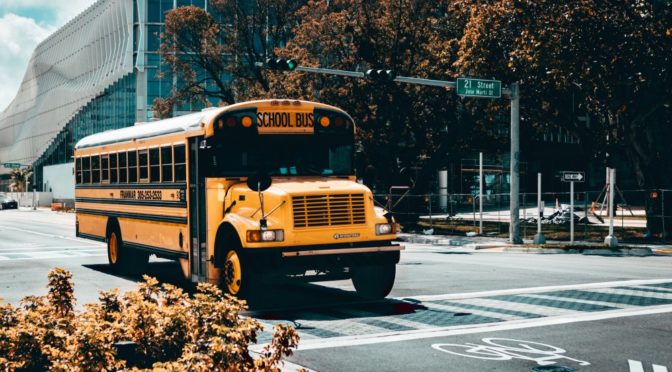
Keeping kids safe around auto traffic isn’t just about car seats–that’s just a part of the equation. The broader picture involves infrastructure, driver choices, and vehicle safety. Choosing a safe car seat and using it correctly falls under driver choices and vehicle safety. But what about when the vehicle is your child’s school bus and the infrastructure involves the bus route and bus stop?
Let’s talk about how to optimize things.
If you’re a parent, grandparent, foster parent, or any kind of caring adult involved in the life of a child, you’ve probably noticed that not all bus stops are created equally. Certain neighborhoods (the wealthy ones) tend to get bus stops far away from traffic, on quiet, practically dead-end roads and cul-de-sacs, on streets so safe you could let your baby crawl about while you went to fetch the paper.
Other neighborhoods? You know the ones. They get the bus stops practically in the middle of the highway. To get to the stop, your kids might need to walk along up to a mile or two of high-speed traffic, most likely without a sidewalk, often without a shoulder, and so on. Or you’ll have the stops that require your kids to cross multiple lanes of traffic with nothing but a hexagon and their prayers to protect them. This, incidentally, was exactly the kind of “stop” that led to the deaths of Xzavier, Mason, and Alivia on October 30th, 2018 in Rochester, Indiana.
The worst part of that story – and of all of these stories – is that the school districts almost always have a very good idea of the risks involved in setting up these awful bus routes and stops. They don’t change them for the same reasons powerful people do bad things everywhere – because they think they can get away with them. And they think so because for the vast portion of recorded and unrecorded history, they’ve been right.
So how do you prevent this as a 21st-century advocate and reader of the Car Crash Detective?
You channel your inner Legally Blonde!

There are certain buzz words that strike fear into the hearts of school boards. There are things their lawyers don’t want to hear in a court of law, because if it’s proven they heard them at any point in the past from a parent, the school district will need to start writing 6, 7, or 8 figure checks to parents. These are the words you want in writing. These are the words you want to share with your principal, your school board, your superintendent. These are the words that will bring an end to whichever gauntlet an HR weenie decided your child would run each day simply because you were zoned as a “non-VIP” parent.
Child Endangerment.
Legal Implications.
Willful Negligence.
Criminal Negligence.
Risk of Harm.
Grievous Bodily Injury.
You get the idea. You don’t need a ton of these words. You just need a few of them, and you just need them in writing. If you show up in person with your complaints in addition to your letter (typed), you’ll get an even quicker response. Perhaps as quickly as the day after your complaint. But you do have to use this kind of language, and you do have to make it clear that A.) the school district is putting children at risk of grave injury due to bus stops or bus routes, and B.) you have made the school district aware of your concerns.
This is a powerful process, and not one to be used lightly. But it’s the second quickest way to avoid senseless deaths due to criminally negligent bus stop placements. The first way, of course, is to have children mowed down by oncoming traffic.
 If you find my information on best practices in car and car seat safety helpful, you can buy my books here or do your shopping through this Amazon link. Canadians can shop here for Canadian purchases. It costs nothing extra to do so, but when you shop through my links, a small portion of your purchase, regardless of what you buy, will go toward the maintenance of The Car Crash Detective.
If you find my information on best practices in car and car seat safety helpful, you can buy my books here or do your shopping through this Amazon link. Canadians can shop here for Canadian purchases. It costs nothing extra to do so, but when you shop through my links, a small portion of your purchase, regardless of what you buy, will go toward the maintenance of The Car Crash Detective.

